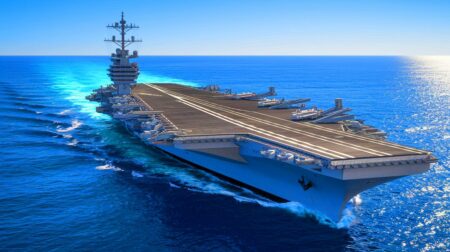| IN A NUTSHELL |
|
The maritime defense landscape is undergoing a significant transformation as Europe unveils its newest and most formidable addition to naval warfare—the largest aircraft carrier ever built on the continent. Weighing an impressive 88,000 tons, this colossal warship not only exemplifies military might but also showcases the pinnacle of technological and industrial innovation. As geopolitical tensions escalate worldwide, European nations are increasingly focused on bolstering their maritime defense capabilities. This ambitious project heralds a new era for warships, promising to redefine naval power standards. What makes this aircraft carrier so exceptional, and what could its implications be for Europe and the global stage?
The Impressive Features of the Aircraft Carrier
This new European aircraft carrier stands as a beacon of maritime power and technological innovation, majestically navigating the seas. Its advanced capabilities and modern design signify a tremendous leap toward enhanced military cooperation between European nations.
The first striking feature of this carrier is its colossal size. Weighing in at 88,000 tons, it surpasses all other European warships by a significant margin. However, it’s not just about size; the vessel’s capabilities are equally impressive. Designed to accommodate a wide array of combat aircraft, drones, and helicopters, it offers unparalleled operational versatility. The ship’s architecture maximizes the efficiency and speed of aerial operations, boasting optimized flight decks and hangars.
In terms of propulsion, the carrier employs a nuclear system, granting it extraordinary autonomy. This means it can sail for extended periods without requiring refueling, a major asset for high-seas missions. This feature sets it apart from conventional ships reliant on fossil fuels. While the use of nuclear energy for propulsion presents significant technical challenges, it also ensures a reduction in carbon emissions, a positive point amid a global energy transition.
Moreover, the carrier is equipped with the most advanced communication and radar technologies, ensuring optimal surveillance and coordination with other naval and aerial units. This makes it not only a formidable combat platform but also an essential maritime command center for international operations. The integration of these sophisticated systems results from collaborations with multiple European tech companies, underscoring the project’s emphasis on collective innovation.
Strategic Importance for Europe
The commissioning of this aircraft carrier marks a monumental step forward in Europe’s defense strategy. In a world where international tensions often manifest through naval power displays, possessing such a ship provides Europe with greater influence on the global stage. More than just an addition to the fleet, this carrier symbolizes Europe’s capability to defend itself and project power where necessary.
The presence of such a large carrier allows Europe to strengthen alliances with other international powers. In fact, a vessel of this capacity can participate in joint missions with other nations, particularly within the NATO framework, thus enhancing ally cohesion and cooperation. This collaborative aspect is crucial in an era where transnational threats require collective and coordinated responses.
Economically, the construction and maintenance of this aircraft carrier also create significant opportunities. Thousands of jobs are generated within the shipbuilding sector and related industries, stimulating local and regional economies. Companies involved in the project benefit not only from financial support but also from increased visibility on the international stage, boosting the competitiveness of European industry.
Technical and Logistical Challenges
Building an aircraft carrier of this magnitude is not without its challenges. The technical requirements are immense, demanding advancements in shipbuilding, nuclear propulsion, and defense systems. Each aspect of the ship must be meticulously planned and executed to ensure not only its effectiveness but also its operational safety.
Nuclear propulsion, for example, requires specialized expertise and strict safety measures to prevent any incidents. Engineers must ensure that the nuclear reactor operates optimally while minimizing potential environmental risks. Although this technology offers impressive autonomy, it also involves increased responsibility in terms of radioactive waste management and accident prevention.
Logistically, managing such a vessel requires flawless coordination. From material supply to crew training, every step must be carefully orchestrated. Logistical support is crucial to maintain the ship’s operational readiness, especially when deployed far from European bases. Port infrastructures must also be adapted to accommodate this maritime giant, possibly necessitating additional investments in existing facilities.
Embedded Technologies Table
| Technology | Function | Advantages |
|---|---|---|
| Nuclear propulsion | Energy supply | Autonomy, emission reduction |
| Advanced radar systems | Surveillance and communication | Early detection, effective coordination |
| Optimized aerial infrastructure | Flight operations | Speed, mission efficiency |
Geopolitical Implications
The commissioning of Europe’s largest aircraft carrier has significant geopolitical implications. In a region where maritime tensions continue to rise, this vessel could become a major strategic asset. Indeed, it provides Europe with enhanced deterrence capabilities, enabling it to respond swiftly to crises.
Furthermore, this carrier could serve as a platform for projecting peace and security in unstable areas. Its presence could deter hostile actors from undertaking aggressive actions while bolstering Europe’s ability to conduct humanitarian and peacekeeping operations. This proactive approach may alter the dynamics of international relations, positioning Europe as a key player in promoting global stability.
Finally, this development could prompt other nations to reassess their own naval strategies. The emergence of such a giant could trigger a naval arms race, as each country seeks to bolster its own fleet to maintain power balance. This raises questions about the future of international cooperation in maritime security and how nations can work together to prevent conflicts.
This aircraft carrier represents a bold vision for the future of European defense. It embodies a collective determination to equip itself with the necessary means to face tomorrow’s challenges. This project is not just a technological feat but also a symbol of Europe’s commitment to play a leading role on the global stage. As the ship prepares to set sail, it is essential to consider the implications of this advancement. How will this aircraft carrier influence international relations? What contributions will it make to global security? And how will Europe continue to innovate to remain at the forefront of naval technology? These questions will remain at the heart of discussions as this maritime giant embarks on its journey.
Did you like it? 4.5/5 (21)








Wow, 88,000 tons? That’s more than my mother-in-law’s meatloaf! 😂